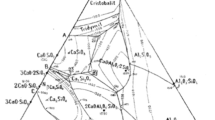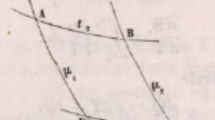Summary
The third law is generalized to the effect that for systems in internal thermodynamic equilibrium, either the entropy tends to zero with the temperature, implying a state of complete order, or the entropy tends to its maximum value as the temperature increases without limit, indicating a state of complete disorder.
Similar content being viewed by others
References
Wilks J.,The Third Law of Thermodynamics (Oxford University Press, London) 1961, pp. 32–33.
Callen H. B.,Thermodynamics, 2nd edition (Wiley, New York, N.Y.) 1985, p. 30.
Hardy G. H., Littlewood J. E. andPólya G.,Inequalities, 2nd edition (Cambridge University Press, London) 1952, Sect. 3.5.
Dunning-Davies J.,Found. Phys. Lett,6 (1993) 289.
Jensen J. L. W. V.,Acta Math.,30 (1906) 175.
Landsberg P. T. andTranah D.,Collective Phenomena,3 (1980) 73.
Landsberg P. T. andTranah D.,Phys. Lett. A,78 (1980) 219.
Lorentz H. A.,Lectures on Theoretical Physics, Vol.II (Macmillan, London) 1927, p. 246.
Khinchin A. I.,Mathematical Foundations of Statistical Mechanics, translated byG. Gamow (Dover, New York, N.Y.) 1949, Sect. 33.
Lavenda B. H.,Statistical Physics: A Probabilistic Approach (Wiley-Interscience, New York, N.Y.) 1991, Chapt. 4.
Gnedenko B. V. andKolmogorov A. N.,Limit Distributions for Sums of Independent Random Variables (Addison-Wesley, Cambridge) 1954.
Lavenda B. H. andFlorio A.,Int J. Theor. Phys.,31 (1992) 1455.
Lavenda B. H. andCompiani M.,Phys. Essays,6 (1993) 320.
Lavenda B. H.,Z. Naturforsch. A,48 (1993) 557.
Bekenstein J. D.,Lett. Nuovo Cimento,4 (1972) 737;Phys. Rev. D,7 (1973) 2333;9 (1974) 3292;Hawking S. W.,Phys. Rev. D,13 (1976) 2460;Bekenstein J. D.,Phys. Rev. D,49 (1994) 1912.
Lavenda B. H. andDunning-Davies J.,Nature,368 (1994) 284.
Aczel J. andDaróczy Z.,On Measures of Information and their Characterization (Academic Press, New York, N.Y.) 1975, p. 36.
Lavenda B. H. andDunning-Davies J.,Found. Phys. Lett.,3 (1990) 435.
Tranah D. andLandsberg P. T.,Collective Phenomena,3 (1980) 81;Landsberg P. T.,J. Stat. Phys.,35, (1984) 159;Landsberg P. T., inBlack Hole Physics, edited byV. de Sabbata andZ. Zhang (Huwer, Dordrecht) 1992.
Author information
Authors and Affiliations
Additional information
The authors of this paper have agreed to not receive the proofs for correction.
Work supported by the EU Human Capital and Mobility Programme (Contract No. ERBCHRXCT920007).
Rights and permissions
About this article
Cite this article
Lavenda, B.H., Dunning-Davies, J. Essence of the third law: The delineation of two forms of thermodynamics. Nuov Cim B 110, 265–276 (1995). https://doi.org/10.1007/BF02741368
Received:
Accepted:
Published:
Issue Date:
DOI: https://doi.org/10.1007/BF02741368




